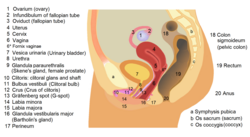This article needs additional citations for verification. (November 2019) |
| Female reproductive system (human) | |
|---|---|
 Pictorial illustration of the female reproductive system and nearby organs | |
| Details | |
| Identifiers | |
| Latin | systema genitale femininum |
| MeSH | D005836 |
| TA98 | A09.1.00.001 |
| TA2 | 3469 |
| FMA | 45663 |
| Anatomical terminology | |

9. Vagina: 10. Hymen; 11. Lumen; 12. Wall; 13. Fornix (lateral)
14. Uterus: Parts: 15. Cervix; 16. Body and 17. Fundus. 18. Orifices: external and internal; 19. Cervical canal; 20. Uterine cavity; Layers: 21. Endometrium; 22. Myometrium and 23. Perimetrium
24. Fallopian tube: 25. Isthmus; 26. Ampulla; 27. Infundibulum; 28. Fimbriae (with 29. Fimbria ovarica)
30. Ovary
31. Visceral pelvic peritoneum: 32. Broad ligament (with 33. Mesosalpinx; 34. Mesovarium and 35. Mesometrium)
Ligaments: 36. Round; 37. Ovarian; 38. Suspensory of ovary
Blood vessels: 39. Ovarian artery and vein; 40. Uterine artery and veins; 41. Vaginal artery and veins
Other: 42. Ureter; 43. Pelvic floor (Levator ani); 44. Femoral head; 45. Hip bone; 46. Internal iliac vessels (anterior branches); 47. External iliac vessels; 48. Abdominal cavity
The human female reproductive system is made up of the internal and external sex organs that function in the reproduction of new offspring. The reproductive system is immature at birth and develops at puberty to be able to release matured ova from the ovaries, facilitate their fertilization, and create a protective environment for the developing fetus during pregnancy. The female reproductive tract is made of several connected internal sex organs—the vagina, uterus, and fallopian tubes—and is prone to infections.[1] The vagina allows for sexual intercourse, and is connected to the uterus at the cervix. The uterus (or womb) accommodates the embryo by developing the uterine lining.
The uterus also produces secretions which help the transit of sperm to the fallopian tubes, where sperm fertilize the ova. During the menstrual cycle, the ovaries release an ovum, which transits through the fallopian tube into the uterus. If an egg cell meets with sperm on its way to the uterus, a single sperm cell can enter and merge with it, creating a zygote. If no fertilization occurs, menstruation is the process by which the uterine lining is shed as blood, mucus, and tissue.
Fertilization usually occurs in the fallopian tubes and marks the beginning of embryogenesis. The zygote will then divide over enough generations of cells to form a blastocyst, which implants itself in the wall of the uterus. This begins the period of gestation and the embryo will continue to develop until full-term. When the fetus has developed enough to survive outside the uterus, the cervix dilates, and contractions of the uterus propel it through the birth canal (the vagina), where it becomes a newborn. The breasts are not part of the reproductive system, but mammary glands were essential to nourishing infants until the modern advent of infant formula.
Later in life, a woman goes through menopause and menstruation halts. The ovaries stop releasing eggs and the uterus stops preparing for pregnancy.
The external sex organs are also known as the genitals, and these are the organs of the vulva, including the labia, clitoris, and vestibule.[2] The corresponding equivalent among males is the male reproductive system.
- ^ Scoullar, Michelle J. L.; Boeuf, Philippe; Peach, Elizabeth (2021). "Mycoplasma genitalium and Other Reproductive Tract Infections in Pregnant Women, Papua New Guinea, 2015–2017 - Volume 27, Number 3—March 2021 - Emerging Infectious Diseases journal - CDC". Emerging Infectious Diseases. 27 (3): 894–904. doi:10.3201/eid2703.201783. PMC 7920647. PMID 33622474. Archived from the original on 9 October 2022. Retrieved 9 October 2022.
- ^ Ellis, Harold; Mahadevan, Vishy (2013). Clinical anatomy: applied anatomy for students and junior doctors (13th ed.). Chichester, West Sussex, UK: Wiley-Blackwell. ISBN 978-1-118-37376-7.